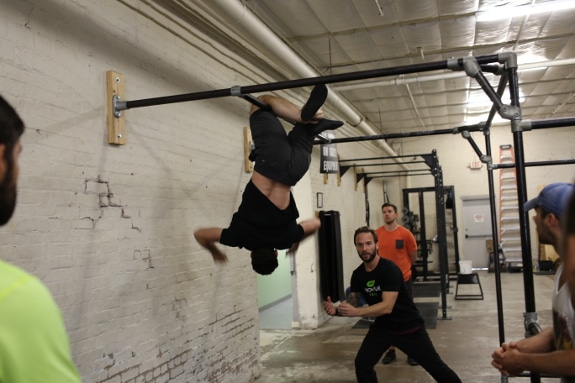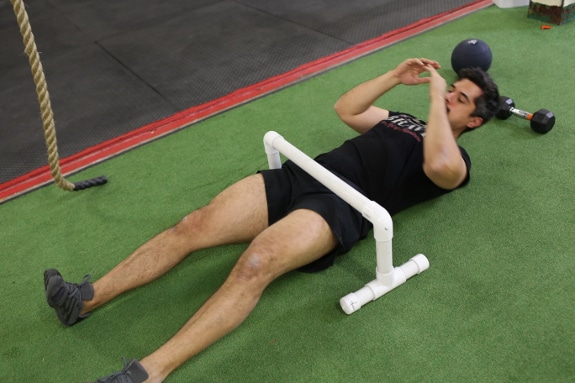Back in 2013, I got an email from a French guy named Erwan Le Corre. He said he was the founder of something called Natural Movement (MovNat) and wanted to write an article for us about how to do things like lift and carry a log efficiently.
I had never heard of MovNat, so I Googled it and discovered that Erwan was teaching, refining, and systemizing a fitness program used by the ancient Greeks and Romans and revitalized in the 19th century by men like Georges Hebert with his book The Natural Method.
The philosophy behind MovNat is simple: humans intrinsically know how to physically move their bodies, and itch to do so in a wide variety of ways. But decades of fitness trends that have concentrated on counting calories, using machines, and exercising in indoor gyms, alongside an increasingly sedentary lifestyle, have left people overweight, injured, and “working out” in narrow, confined, artificial, and predictable ways. MovNat seeks to restore our knowledge of how to move naturally, and how to perform such movements in the most efficient and effective way possible.
MovNat aims to help people reach their physical potential and make them functionally fit and proficient at doing the basic movements the human body was designed to do: walking, running, crawling, hanging, throwing, swimming, jumping, balancing, and so on. MovNat is also all about getting outside and mixing up the environment in which you move. Sure, you can do a pull-up on the bar at the gym, but can you do one on a tree branch? You can lift a uniformly-shaped barbell, but could you hoist an oddly-shaped log? You can run a mile, but could you run barefoot over rocks? You might be strong, but are you tough?
The ultimate end goal of MovNat isn’t washboard abs, increasing the amount of weight you can lift, or leveling up the number of box jumps you can do for time (though it might indirectly help you with all those things). Rather, the motto of MovNat is “be strong to be useful.” MovNat doesn’t teach fitness as an end in and of itself; rather, you learn all these practical movements so that you’re always ready to help others, and even save a life, no matter the emergency or scenario.
Erwan lays all of this out in more detail in a couple of articles he ended up writing for us on the history of physical fitness and the principles of MovNat.
His pieces left me duly intrigued; a fitness philosophy based on the training of ancient warriors, exercising like a modern Tarzan, and serving others? Where could I sign up? Both Kate and I kept thinking about getting more into MovNat ourselves. And thinking about it. And thinking about it. We just kept putting it off. Adult-onset inertia problems are a real thing.
But we finally decided that 2016 was the year we’d become MovNat-ers. We contacted one of their head instructors about attending a MovNat workshop and he kindly invited us to come to one free of charge. And we did just that last month in Houston, TX. Below you’ll find my report.
Note: While we got in gratis, I’m not affiliated with MovNat nor was I paid to write this review. I just wanted to share my experience for those interested.
The Prelude: Training With Aaron
Tulsa, OK usually isn’t on the forefront of trends — fitness or otherwise. I’ll see something cool going on in other cities, wonder why we don’t have that here, and then wait a few years for it to finally migrate its way inland. But in the case of MovNat, we’re fortunate to already have a Level 2 certified instructor here in town: Aaron Baulch, owner of Mindful Body Fitness.
Aaron has had an impressive and diverse fitness career. Back in the late 1990s, he was a bodybuilder competing in the super heavyweight division. But due to the stress and injuries he accumulated while sculpting his massive physique, Aaron retired and began exploring other fitness philosophies that could help him recover his health. He started off with yoga, which led to kettlebells, and his getting certified to be a coach in the Russian Kettlebell Challenge. Then he discovered parkour, which led him to MovNat.
While Aaron continues to teach MovNat, his main focus has shifted to “restorative movement” — helping older people who have a hard time simply getting around, as well as beat-up former athletes who struggle to be active without pain. He uses skills from MovNat, along with practice from other “movement schools” like yoga and the Katy Bowman system, to get people going again.
A few months before the MovNat workshop in Houston, Kate and I hired Aaron to come over to our place once a week for private sessions. Each Tuesday, Aaron would cover a few of the basic MovNat skills with us. What’s more, he created tailored restorative movement routines for both Kate and I to help with our respective fitness practices — running for Kate, barbell training for me. After several months of working with Aaron, we both felt well-prepared for the workshop, and I had worked out some kinks and tightness that had been holding up my lifting progress.
The MovNat Workshop
MovNat workshops, which are held around the country, take place over 2 days, typically on the weekends. They run from 9am-4pm on Saturday and Sunday, and overlap with Level 1 Certifications, for those who want to become certified MovNat trainers. The content of the weekend is pretty much the same for those who are just there for the workshop, and those who are getting certified, except that the latter start the workshop on Friday, and come earlier and leave later for the Sat/Sun sessions in order to take tests and get more instruction in how to coach others in MovNat.
Day 1: Learning The Skills
The workshop we attended was held at a place called Studio Fitness in Houston, TX. It’s a large facility that has an area dedicated just to parkour, MovNat, and CrossFit workouts. This is where Urban Movement, the parkour and MovNat-affiliate owned by Cameron Pratto, is headquartered.
Once we arrived, we met our coaches.
Now, with a program started by a French guy that’s all about moving naturally, and being in nature, you might expect it to attract a lot of Gaia-worshiping, granola crunchers who are looking to frolic in the woods. But with an emphasis on preparedness and toughness, a whole combatives program, and a wicked hard Level 3 certification (which includes stuff like jumping off a 7-ft platform and landing in a roll) MovNat’s leadership is actually filled with a lot of strong, virile dudes.
Not only is Aaron the most ripped yoga enthusiast I’ve ever met, our two coaches for the workshop have some really impressive fitness resumes. Cameron Pratto comes from a parkour background and even trained with the founders of the movement in France. Through parkour, Cameron discovered MovNat and instantly got hooked. He’s now part of the MovNat Certification Team and travels the world to train other instructors.
Our other coach, Danny Clark, co-owns a gym in Connecticut called Rebar Fitness along with his wife, Abby. Danny wrestled for the University of Virginia while in college and then later transitioned to Brazilian jiu-jitsu and MMA. He won the bronze medal for Team USA at the World Grappling Championships in Krakow, Poland in 2012. Danny is the Performance Director and Master Instructor at MovNat and is heading up the work on further systemizing the program.
Both Cameron and Danny were excellent coaches. (I think there’s typically one coach per workshop, but because Cameron had recently gotten into a motorcycle accident, Danny flew in to assist. Tough break for Cameron, but getting two top-notch coaches was a fortunate one for us!) They were able to convey the movements clearly to the entire class while also providing individualized one-on-one feedback when needed. They understand the movements and how the body works so well that they were able to use simple, easy-to-understand coaching “cues” to convey the needed corrections in a clear way.
After meeting the coaches, the workshop began with all the participants going around introducing themselves. There were about a dozen of us, and we hailed from a wide variety of backgrounds and fitness interests. A little over half were personal trainers seeking to get certified in MovNat, including a former collegiate swimmer and a professional tennis player. We also had a few physical therapists in the mix looking to get insights to help their clients. There was also a handful of average folks (like Kate and me) looking to improve their movement ability.
After the introductions, we got to work.
The first day of the workshop was dedicated to learning all the basic Level 1 MovNat skills: crawling, balancing, lifting, throwing, carrying, running, jumping, and hanging. Within each of these skills are smaller sub-skills. For example, with crawling you don’t only learn the basic crawl, but also the army crawl, crab crawl, back crawl. Any way you could crawl, we did it.
But we didn’t start off moving like Paleolithic human-apes right off the bat. We began with breathing. Breathing? Well, come to find out, modern folks are terrible at breathing the way nature intended. Instead of breathing deeply from our belly, we breathe shallowly from our chest and neck. This sort of breathing induces the stress response and prevents our body and brain from getting the oxygen it needs to perform optimally. So we did some belly breathing. (Look for an article on this in the future.)
After re-leaning how to breathe, we started moving, and other than a lunch break, we didn’t stop moving until 4pm.
Balancing was my favorite skill we worked on that day. Jumping was fun too. We did broad jumps and learned how to jump down from high places safely and efficiently.
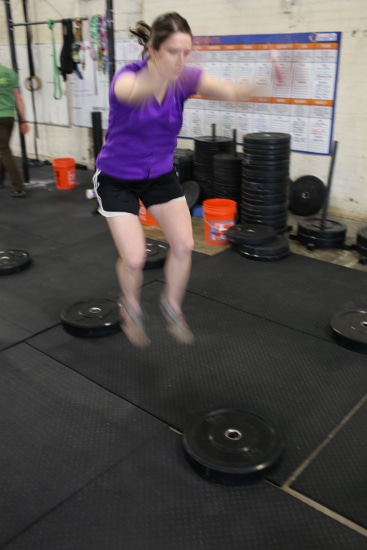
Kate taking flight as we jumped from weight plate to weight plate.
Hanging? Not so much. It’s hard work hanging your 215-lb body by your hands on a bar. But then that was Kate’s favorite skill. Different strokes for different folks.
The emphasis with all the skills was learning how to do them effectively and efficiently — not only how to get the job done, but how to get it done in the smoothest, least energy-intensive, most injury-minimizing way. Just because a movement is natural, doesn’t mean you’ve ever learned the best way to do it. Even though I already knew the basics of the movements because of my training with Aaron, I still found a bunch of ways to further refine my technique.

Busting out something called the tripod transition.
One of the things I liked best about these skill tutorials (and MovNat in general) is that the coaches always went over what the practical application was. Balancing, for instance, can come in handy for crossing a log over a stream when hiking; throwing is for when you’re working a sandbag line and pitching a load to the next guy; crawling is for maneuvering under a low obstacle, etc. The skills aren’t pursued just to get fitter, but to move more agilely in your day-to-day life, and be useful to others in a pinch.
The overall physical expenditure required by Saturday’s session was pretty constant, but light to moderate in intensity. Yet despite not lifting anything incredibly heavy or taking part in any vigorous cardio, by the evening, my body was sore in places I didn’t know existed. I was using muscles I hadn’t used in years. And it felt painfully good.
Day 2: Coaching Evaluations & Fun Time
The second day started off at 9am, and I was even sorer than I was the night before. The morning was spent reviewing the movement skills we learned on Saturday. This time, though, the coaches mixed things up and added some fun by incorporating variations and games. For example, with balancing, rather than just walking forwards and backwards on 2X4s, we had to traverse them while holding sand bags and medicine balls, and stepping over barriers.

Kate intently balances while holding a sandbag and stepping over barriers.
Most of the rest of the day was spent on Cameron and Danny doing coaching evaluations of the participants who were getting certified. The way this worked is that we broke into two groups, and each cert candidate took a turn practicing coaching the rest of the group on one of the MovNat skills. Cameron or Danny would then ask everyone in the group for their feedback on how he or she did. This time was definitely more about the cert candidates than the workshop participants, and it was less engaging to have less experienced coaches review concepts we had gone over the day before. A little repetition and practice is good though, and I didn’t mind it too much. However, Kate, who by nature has a restless disposition and likes to always be moving, found it a little slow and wished the time had been spent more actively.
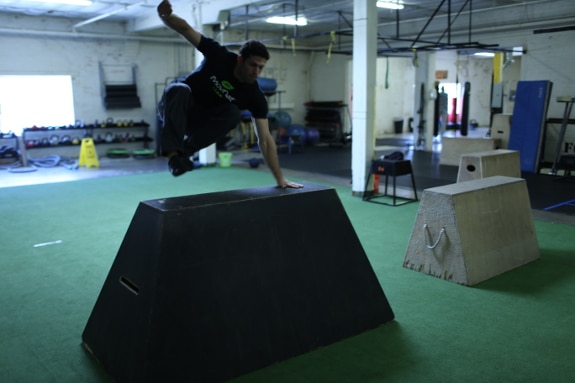
Danny demonstrates a vault.
Fortunately, the day ended with working on a skill we both found to be the weekend’s most fun: vaulting. You know — parkour stuff. While we focused on the very basics, I had a blast doing it. I felt like I was taking part in a real-life Assassin’s Creed, minus jumping into carts of hay.
Sunday’s session came to a close with a roundtable discussion, led by Cameron, about general lifestyle habits that we can use in addition to MovNat to help create a healthy and active life. It was basic stuff — sleep better, manage stress, spend time outside — and I’m not sure it was necessary.
With that, our MovNat workshop was over, and it was time to head back to T-town, OK.
My Verdict on the MovNat Workshop Specifically, and MovNat Generally
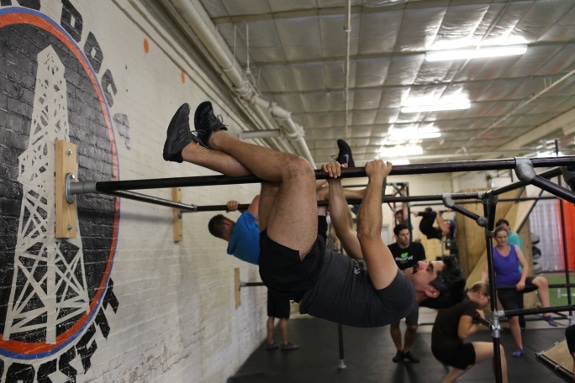
MovNat will be hanging around my fitness routine.
If you’ve ever heard of MovNat and wondered what it was all about, or if you just feel like your fitness routine and philosophy (you do have a fitness philosophy, right?) is lacking in some way, I really recommend attending a MovNat workshop.
On the con side, it is pretty pricey ($420 for the weekend), and it would be nice if they gave folks the option of just doing one day, instead of having to buy the package of two. Saturday is definitely the most educational and engaging of the two days.
But on the pro side, you get 14 solid hours of quality small group coaching, and a chance to jump into MovNat feet first. You don’t have to have done any MovNat training before you attend a workshop, though it can beneficial; you’re going over a ton of skills in a relatively short amount of time, so having a contextual foundation already will allow you to hit the ground running and get more out of each tutorial. But you could go without any background in MovNat, have a good time, learn a ton, and walk out knowing how to move your body a lot more effectively and efficiently. Plus, if you attend the workshop in your hometown, it provides a chance to get to know some folks in the MovNat community and learn how to get more involved.
So whether, you run, barbell train, or do BJJ, check out a MovNat workshop when/if there’s one in your neck of the woods. You’ll learn a lot, meet great people, and have a lot of fun.
If there isn’t a workshop near you, then I’d recommend getting involved with MovNat in other ways. Search to see if there’s a MovNat-related gym and/or trainer in your area. You can also visit MovNat.com to learn the basic movements as well as sign up for MODs or “Movements of the Day” that you can do on your own.
Regardless of what sports or fitness disciplines you’re into, MovNat can be an asset and support to what you’re already doing.
As I mentioned above, MovNat has been a fantastic supplement to my strength training. I’ve struggled for years with tightness in my shoulders and chest that has made it hard to get under the bar properly for a low-bar squat. The tightness has come from spending too much time hunched over a computer. Crawling and hanging regularly, along with some other restorative movements, have helped open those areas up and I can now get the bar in its proper place with less difficulty. Practicing movement exercise has also helped my shoulder, and in my bench press.
Another problem area that MovNat has helped with is in the squat itself. My hip flexors and abductors are super tight — again, caused by years of sitting. Despite doing warm-up sets before my work sets, I usually can’t get down to depth until my second one. My strength coach, Matt Reynolds, always gives me a hard time about that. There are a few movement patterns in MovNat, like lateral sit, that have helped me open up those areas. I get in that position when I’m playing with the kids on the floor or when I’m watching TV. Along with some other restorative movements, my flexibility in those areas has improved significantly and I can get down to depth much easier now.
The biggest contribution MovNat has made me to my life is simply making me more intentional about moving throughout the day. Our bodies are made to move. When you stay seated in the same position for hours a day, week in and week out, it wreaks havoc on your body. Most of the health issues modern Westerns face today don’t stem from over-exertion, but under-exertion. Your metabolism slows to a standstill and tightness forms to compensate for your poor body positioning and movement. The changes happen so slowly that you don’t even realize what your lack of movement is doing to you. That is, until you find yourself breathless while roughhousing with your kids and you tweak your lower back when you stoop to pick up a 50-pound load of mulch while doing yard work.
Now that I’m in my 30s, I’m especially cognizant of the need to stay active and nimble in the decades to come, and know my ability to do that depends on what I do now from day to day.
Since starting with MovNat and especially after the workshop, I find myself looking to take what Aaron calls “movement snacks” throughout the day. After sitting for 30 minutes, I’ll get down on the floor and do some lateral sits and some short back and forth crawling. When I’m talking on the phone, I’ll get up and walk around and maybe even lower myself down into a full squat. When I pass the pull-up bar in my garage, I’ll hang from it for a few seconds.
It’s also brought more “play” into my life. After doing MovNat for a few months, I see my world differently. That curb over there? I could do some balancing on it. Those big rocks? I could jump on top of them and broad jump across them.
MovNat has had the same effect on our kids. As 5- and 2-year-olds respectively, Gus (who’s been taking his own MovNat lessons) and Scout (who’s picked up on it from watching the rest of the family), already move around a lot anyways, but since practicing MovNat has become part of our family culture, they look for opportunities to do it even more — climbing and balancing on whatever they see and talking about the cool “MovNat” they’re doing. They don’t think it’s a workout; they’re just having fun. But in the process of playing MovNat, they’re developing a love of fitness and physical activity that will hopefully last a lifetime.
If my review of MovNat has piqued your interest, well, you’re in luck. We plan on delving into more of its principles in the coming months and years. Stay tuned.
And get moving!
Be sure to listen to my interview with Erwan all about MovNat and the natural method:




